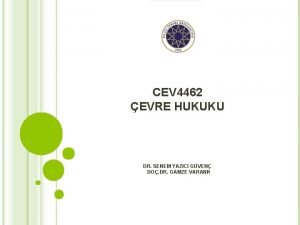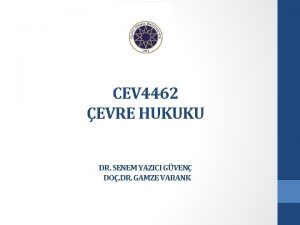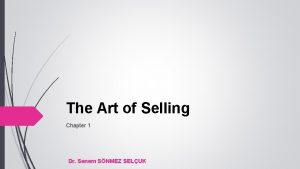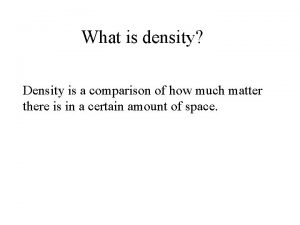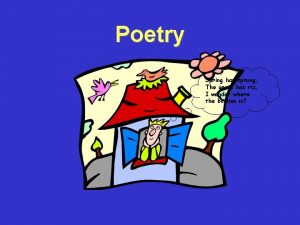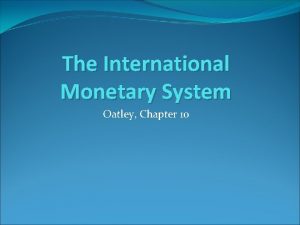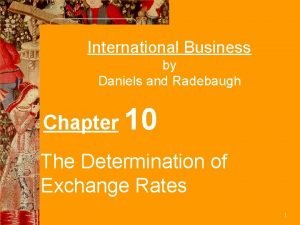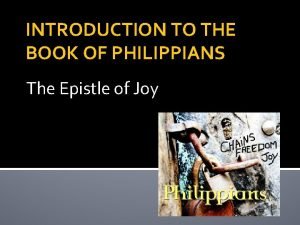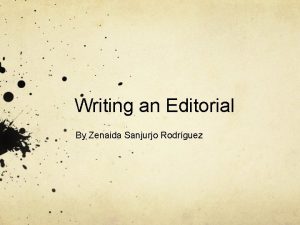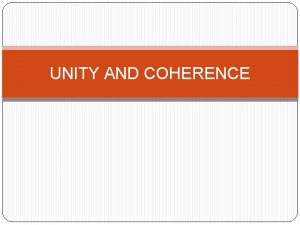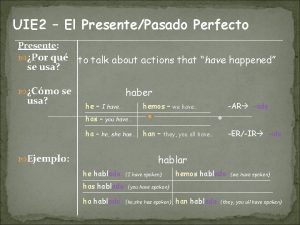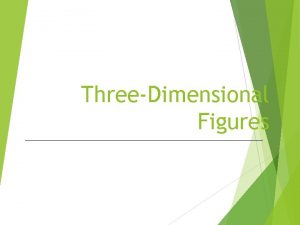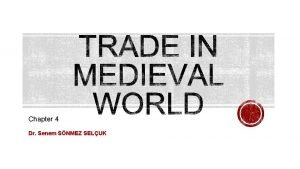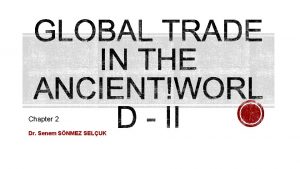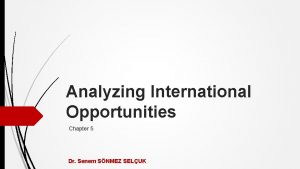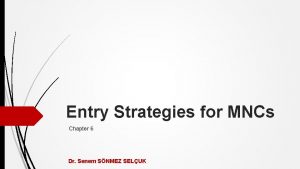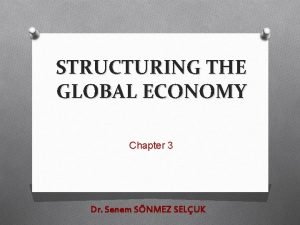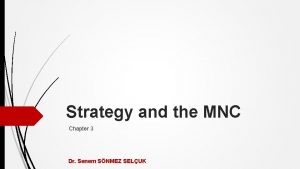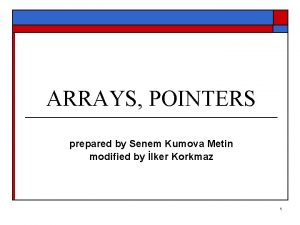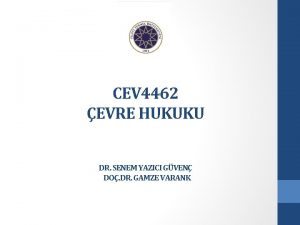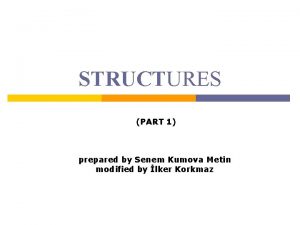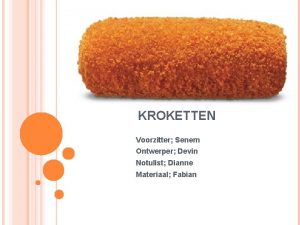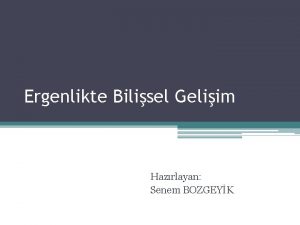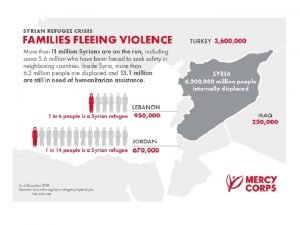Chapter 5 Dr Senem SNMEZ SELUK Nowhere has


























































- Slides: 58

Chapter 5 Dr. Senem SÖNMEZ SELÇUK

§ Nowhere has the dynamic and even ruthless energy of Western civilization been more apparent than in its expansion into the rest of the world. § By the late sixteenth century, century the Atlantic seaboard had become the center of a commercial activity that raised Portugal and Spain and later the Dutch Republic, Republic England, England France to prominence. § The age of expansion was a crucial factor in the European transition from the agrarian economy of the Middle Ages to a commercial and industrial capitalistic system. Expansion also led Europeans into new and lasting contacts with non-European peoples that inaugurated a 2 new age of world history in the sixteenth century.

§ For almost a millennium, Catholic Europe had been confined to one geographic area. Its one major attempt to expand beyond those frontiers, the Crusades, had largely failed. § Of course, Europe had never completely lost touch with the outside world: the goods of Asia and Africa made their way into medieval castles, castles the works of Muslim philosophers were read in medieval universities, universities and in the ninth and tenth centuries, the Vikings had even made their way to the eastern fringes of North America But in all cases, contacts with non-European civilizations remained limited until the end of the fifteenth century, when Europeans embarked on a remarkable series of overseas journeys. 3

§ Although Muslim control of Central Asia cut Europe off from the countries farther east, the Mongol conquests in the thirteenth century had reopened the doors § But in the fourteenth century, century the conquests of the Ottoman Turks and then the breakup of the Mongol Empire reduced Western traffic to the East § With the closing of the overland routes, routes a number of people in Europe became interested in the possibility of reaching Asia by sea to gain access to the spices and other precious items of the region. INTF 3473 - History of World Trade 4

§ An economic motive thus looms large in European expansion in the Renaissance. Merchants, adventurers, and government officials had high hopes of finding precious metals and new areas of trade, especially more direct access to the spices of the East § These continued to come to Europe via Arab intermediaries but were outrageously expensive. Many European explorers and conquerors did not hesitate to express their desire for material gain. INTF 3473 - History of World Trade 5

§ Another major reason for the overseas voyages was religious zeal A crusading mentality was particularly strong in Portugal and Spain, Spain where the Muslims had largely been driven out in the Middle Ages. § Contemporaries of Prince Henry the Navigator of Portugal said that he was motivated by ‘‘his great desire to make increase in the faith of our Lord Jesus Christ and to bring him all the souls that should be saved. ’’ § Although most scholars believe that the religious motive was secondary to economic considerations, considerations it would be foolish to overlook the genuine desire on the part of both explorers and conquistadors, let alone missionaries, to convert the heathen to Christianity. § Spiritual and secular affairs were closely intertwined in the sixteenth century. No doubt, the desire for grandeur and glory as well as plain intellectual curiosity and a spirit of adventure also played some role in European expansion. 6

§ If ‘‘God, glory, and gold’’ were the primary motives, motives what made the voyages possible? § First of all, the expansion of Europe was connected to the growth of centralized monarchies during the Renaissance. Although historians still debate the degree of that centralization, the reality is that Renaissance expansion was a state enterprise § By the second half of the fifteenth century, European monarchies had increased both their authority and their resources and were in a position to turn their energies beyond their borders. INTF 3473 - History of World Trade 7

§ At the same time, Europeans had achieved a level of wealth and technology that enabled them to make a regular series of voyages beyond Europe. § Although the highly schematic and symbolic medieval maps were of little help to sailors, the portolani, portolani or charts made by medieval navigators and mathematicians in the thirteenth and fourteenth centuries were more useful. § With details on coastal contours, distances between ports, and compass readings, these charts proved of great value for voyages in European waters. § But because the portolani were drawn on a flat scale and took no account of the curvature of the earth, earth they were of little use for longer overseas voyages § Only when seafarers began to venture beyond the coast of Europe did they begin to accumulate information about the actual shape of the earth. By the end of the fifteenth century, cartography had developed to the point that Europeans possessed fairly accurate maps of the known world. 8

§ One of the most important world maps available to Europeans at the end of the fifteenth century was that of Ptolemy, Ptolemy an astronomer of the second century A. D. § Ptolemy’s work, work the Geography, Geography had been known to Arab geographers as early as the eighth century, but it was not until the fifteenth century that a Latin translation was made of the work. Printed editions of Ptolemy’s Geography, which contained his world map, became available from 1477 on. on § Ptolemy’s map showed the world as spherical with three major landmasses ––Europe, Asia, and Africa–– and only two oceans In addition to showing the oceans as considerably smaller than the landmasses, Ptolemy had also drastically underestimated the circumference of the earth, earth which led Columbus and other adventurers to believe that it would be feasible to sail West from Europe to reach Asia. 9

10

§ Europeans had developed remarkably seaworthy ships as well as new navigational techniques. § European shipmakers had mastered the use of the axial rudder (an import from China) and had learned to combine the use of lateen sails with a square rig. With these innovations, they could construct ships mobile enough to sail against the wind and engage in naval warfare and also large enough to mount heavy cannons and carry a substantial amount of goods over long distances § Previously, sailors had used a quadrant and their knowledge of the position of the Pole Star to ascertain their latitude Below the equator, however, this technique was useless. Only with the assistance of new navigational aids such as the compass and the astrolabe were they able to explore the high seas with confidence. INTF 3473 - History of World Trade 11

§ A final spur to exploration was the growing knowledge of the wind patterns in the Atlantic Ocean. § The first European fleets sailing southward along the coast of West Africa had found their efforts to return hindered by the strong winds that blew steadily from the north along the coast. § By the late fifteenth century, however, sailors had learned to tack out into the ocean, where they were able to catch westerly winds in the vicinity of the Azores that brought them back to the coast of western Europe. § Christopher Columbus used this technique in his voyages to the Americas, Americas and others relied on their new knowledge of the winds to round the continent of Africa in search of the Spice Islands. INTF 3473 - History of World Trade 12

§ Portugal took the lead in the European age of expansion when it began to explore the coast of Africa under the sponsorship of Prince Henry the Navigator (1394 -1460). § His motives were a blend of seeking a Christian kingdom as an ally against the Muslims, acquiring trade opportunities for Portugal, and extending Christianity. INTF 3473 - History of World Trade 13

§ In 1419, 1419 Prince Henry founded a school for navigators on the southwestern coast of Portugal. § Shortly thereafter, Portuguese fleets began probing southward along the western coast of Africa in search of gold, gold which had been carried northward from south of the Atlas Mountains in central Morocco for centuries. § In 1441, 1441 Portuguese ships reached the Senegal River, just north of Cape Verde, and brought home a cargo of black Africans, Africans most of whom were then sold as slaves to wealthy buyers elsewhere in Europe § Within a few years, an estimated one thousand slaves were shipped annually from the area back to Lisbon. INTF 3473 - History of World Trade 14

§ Through regular expeditions, the Portuguese gradually crept down the African coast, coast and in 1471, 1471 they discovered a new source of gold along the southern coast of the hump of West Africa (an area that would henceforth be known to Europeans as the Gold Coast). § A few years later, they established contact with the state of Bakongo, Bakongo near the mouth of the Zaire (Congo) River in Central Africa. § To facilitate trade in gold, ivory, and slaves (some slaves were brought back to Lisbon, while others were bartered to local merchants for gold), the Portuguese leased land from local rulers and built stone forts along the coast. INTF 3473 - History of World Trade 15

§ Hearing reports of a route to India around the southern tip of Africa, Portuguese sea captains continued their probing. § In 1488, 1488 Bartholomeu Dias (c. 1450 -1500) took advantage of westerly winds in the South Atlantic to round the Cape of Good Hope, Hope but he feared a mutiny from his crew and returned. § Ten years later, later a fleet under the command of Vasco da Gama (c. 14601524) rounded the cape and stopped at several ports controlled by Muslim merchants along the coast of East Africa. Da Gama’s fleet then crossed the Arabian Sea and reached the port of Calicut, on the southwestern coast of India, on May 18, 1498 § On arriving in Calicut, da Gama announced to his surprised hosts that he had come in search of ‘‘Christians and spices. ’’ He found no Christians, but he did find the spices he sought. § Although he lost two ships en route, da Gama’s remaining vessels returned to Europe with their holds filled with ginger and cinnamon, cinnamon a cargo that 16 earned the investors a profit of several thousand percent.

§ Portuguese fleets returned annually to the area, area seeking to destroy Arabic shipping and establish a monopoly in the spice trade. § In 1509, a Portuguese armada defeated a combined fleet of Turkish and Indian ships off the coast of India and began to impose a blockade on the entrance to the Red Sea to cut off the flow of spices to Muslim rulers in Egypt and the Ottoman Empire. § In 1511, 1511 Admiral Afonso de Albuquerque (c. 1462 -1515) sailed into the harbor of Malacca on the Malay peninsula. Malacca had been transformed by its Muslim rulers into a thriving port and a major stopping point for the spice trade. For Albuquerque, control of Malacca would serve two purposes. It could help destroy the Arab spice trade and also provide the Portuguese with a way station on the route to the Moluccas, then known as the Spice Islands. After a short but bloody battle, the Portuguese seized the city and massacred the local Arab population. § From Malacca, the Portuguese launched expeditions farther east, to China and the Spice Islands. There they signed a treaty with a local ruler for the purchase and export of cloves to the European market. The new trading empire was now complete. 17

§ Within a few years, the Portuguese had managed to seize control of the spice trade from Muslim traders and had garnered substantial profits for the Portuguese monarchy. § Nevertheless, the Portuguese Empire remained limited, consisting only of trading posts on the coasts of India and China. The Portuguese lacked the power, the population, and the desire to colonize the Asian regions. § The Portuguese by no means possessed a monopoly on the use of firearms and explosives, explosives but their effective use of naval technology, technology their heavy guns that could be mounted in the hulls of their sturdy vessels, and their tactics gave them military superiority over lightly armed rivals that they were able to exploit until the arrival of other European forces several decades later. INTF 3473 - History of World Trade 18

§ While the Portuguese were seeking access to the spice trade of the Indies by sailing eastward through the Indian Ocean, the Spanish were attempting to reach the same destination by sailing westward across the Atlantic. § Although the Spanish came to overseas discovery and exploration after the initial efforts of Henry the Navigator, their greater resources enabled them to establish a far grander overseas empire quite different from that of the Portuguese. INTF 3473 - History of World Trade 19

§ An important figure in the history of Spanish exploration was an Italian known as Christopher Columbus (1451 -1506). § Knowledgeable Europeans were aware that the world was round but had little understanding of its circumference or the extent of the continent of Asia. § Convinced that the circumference of the earth was less than contemporaries believed and that Asia was larger than people thought, Columbus felt that Asia could be reached by sailing west instead of around Africa. § After being rejected by the Portuguese, he persuaded Queen Isabella of Spain to finance his exploratory expedition. INTF 3473 - History of World Trade 20

§ With three ships, ships the Santa Maria, the Nina, and the Pinta, and a crew of ninety men, men Columbus set sail on August 3, 1492 § On October 12, he reached the Bahamas and then went on to explore the coastline of Cuba and the northern shores of Hispaniola (present-day Haiti and the Dominican Republic). § Columbus believed that he had reached Asia, Asia and in his reports to Queen Isabella and King Ferdinand upon his return to Spain, he assured them not only that he would eventually find gold but also that they had a golden opportunity to convert the natives ––whom Columbus persisted in calling ‘‘Indians’’–– to Christianity § In three subsequent voyages (1493, 1498, 1502), Columbus sought in vain to find a route to the Asian mainland. § In his four voyages, Columbus landed on all the major islands of the Caribbean and the mainland of Central America, still convinced that he had reached the Indies in Asia. 21

§ Although Columbus clung to his belief until his death, other explorers soon realized that he had discovered a new frontier altogether. § State-sponsored explorers joined the race to the New World § A Venetian seaman, John Cabot, explored the New England coastline of the Americas under a license from King Henry VII of England. § The continent of South America was discovered accidentally by the Portuguese sea captain Pedro Cabral in 1500 § Amerigo Vespucci, Vespucci a Florentine, accompanied several voyages and wrote a series of letters describing the geography of the New World. The publication of these letters led to the use of the name ‘‘America’’ (after Amerigo) for the new lands. INTF 3473 - History of World Trade 22

§ The first two decades of the sixteenth century witnessed numerous overseas voyages that explored the eastern coasts of both North and South America. § Vasco Nunez de Balboa (1475 -1519), a Spanish explorer, led an expedition across the Isthmus of Panama and reached the Pacific Ocean in 1513. § Perhaps the most dramatic of all these expeditions was the journey of Ferdinand Magellan (1480 -1521) in 1519 After passing through the strait named after him at the southern tip of South America, he sailed across the Pacific Ocean and reached the Philippines, Philippines where he met his death at the hands of the natives. Although only one of his original fleet of five ships survived and returned to Spain, Magellan’s name is still associated with the first known circumnavigation of the earth. 23

24

§ Portugal and Spain had been the first Atlantic nations to take advantage of the Age of Exploration, starting in the late fifteenth century, and both had become great colonial powers. § In the seventeenth century, however, their European neighbors to the north ––first the Dutch and then the French and English–– moved to replace the Portuguese and Spanish and create their own colonial empires. The new rivals and their rivalry soon had an impact on much of the rest of the world ––in –– Africa, Asia, and the Americas. INTF 3473 - History of World Trade 25

§ Although the primary objective of the Portuguese in sailing around Africa was to find a sea route to the Spice Islands, they soon discovered that profits could be made in Africa itself. So did other Europeans. § The Portuguese built forts on both the western and eastern coasts of Africa and tried, tried above all, to dominate the trade in gold. § During the mid-seventeenth century, however, the Dutch seized a number of Portuguese forts along the West African coast and at the same time took control of much of the Portuguese trade across the Indian Ocean. INTF 3473 - History of World Trade 26

§ The Dutch East India Company, a trading company established in 1602 under government sponsorship, sponsorship also set up a settlement in southern Africa, at the Cape of Good Hope, which was meant to serve as a base to provide food and other provisions to Dutch ships en route to the Spice Islands. § Eventually, however, it developed into a permanent colony Dutch farmers, known as Boers, began to settle in areas outside the city of Cape Town. The area’s moderate climate and freedom from tropical diseases made it attractive for Europeans to settle there. INTF 3473 - History of World Trade 27

§ The European exploration of the African coastline did not affect most Africans living in the interior of the continent, but for peoples living on or near the coast, the impact was great indeed § As the trade in slaves increased during the sixteenth through the eighteenth centuries, centuries thousands and then millions of Africans were removed from their homes and forcibly shipped to plantations in the New World. § Traffic in slaves was not new. As in other areas of the world, slavery had been practiced in Africa since ancient times. In the fifteenth century, it continued at a fairly steady level. INTF 3473 - History of World Trade 28

§ At first, the Portuguese simply replaced European slaves with African ones. During the second half of the fifteenth century, about a thousand slaves were taken to Portugal each year. Most wound up serving as domestic servants for affluent families in Europe. § But the discovery of the Americas in the 1490 s and the planting of sugarcane in South America and the islands of the Caribbean changed the situation drastically INTF 3473 - History of World Trade 29

§ Cane sugar had first been introduced to Europeans from the Middle East during the Crusades. § At the end of the fifteenth century, the Portuguese set up sugar plantations worked by African laborers on an island off the central coast of Africa. During the sixteenth century, sugarcane plantations were set up along the eastern coast of Brazil and on several islands in the Caribbean. § Because the growing of cane sugar demands both skill and large quantities of labor, the new plantations required more workers than could be provided by the small American Indian population in the New World, decimated by diseases imported from the Old World. § Since the climate and soil of much of West Africa were not conducive to the cultivation of sugar, African slaves began to be shipped to Brazil and the Caribbean to work on the plantations. § The first were sent from Portugal, but in 1518, 1518 a Spanish ship carried the first boatload of African slaves directly from Africa to the New World. 30

§ During the next two centuries, the trade in slaves grew dramatically and became part of the triangular trade connecting Europe, Africa, and the American continents that characterized the new Atlantic economy. § European merchant ships (primarily those of England, France, Spain, Portugal, and the Dutch Republic) carried European manufactured goods, such as guns, gin, and cloth, to Africa, where they were traded for a cargo of slaves. The slaves were then shipped to the Americas and sold. § European merchants then bought tobacco, molasses, sugar, rum, coffee, and raw cotton and shipped them back to Europe to be sold in European markets. INTF 3473 - History of World Trade 31

§ An estimated 275, 000 enslaved Africans were exported to other countries during the 16 th century, century with 2, 000 going annually to the Americas alone. § In the 17 th century, the total climbed to over a million and jumped to 6 million in the 18 th century, century when the trade spread from West and Central Africa to East Africa. § Even during the 19 th century, when Great Britain and other European countries tried to end the slave trade, nearly 2 million were exported. § Altogether as many as 10 million African slaves were transported to the Americas between the sixteenth and nineteenth centuries § About half were transported in British ships, with the rest divided among French, Dutch, Portuguese, Danish, and later, American ships. 32

33

§ The effects of the slave trade varied from area to area. § Of course, it had tragic effects on the lives of the slaves and their families. § There was also an economic price as the importation of cheap manufactured goods from Europe undermined local cottage industries and forced countless families into poverty. § The slave trade also led to the depopulation of some areas and deprived many African communities of their youngest and strongest men and women. § The political effects of the slave trade were also devastating The need to maintain a constant supply of slaves led to increased warfare and violence as African chiefs and their followers, armed with guns acquired from the trade in slaves, increased their raids 34 and wars on neighboring peoples.

§ Despite a rising chorus of humanitarian sentiments from European intellectuals, the use of black slaves remained largely acceptable to Western society. Europeans continued to view blacks as inferior beings fit primarily for slave labor. § Not until the Society of Friends, known as the Quakers, began to criticize slavery in the 1770 s and exclude from their church any member adhering to slave trafficking did European sentiment against slavery begin to build. § Even then, it was not until the radical stage of the French Revolution in the 1790 s that the French abolished slavery The British followed suit in 1807 Despite the elimination of the African source, slavery continued in the newly formed United States until the Civil War of the 1860 s. INTF 3473 - History of World Trade 35

§ Between 1500 and 1800, the Atlantic nations of Europe moved into all parts of the world. § The first had been Spain and Portugal, the two great colonial powers of the 16 th century, followed by the Dutch, who built their colonial empire in the 17 th century as Portugal and Spain declined. § The Dutch were soon challenged by the British and French, who outstripped the others in the 18 th century while becoming involved in a bitter rivalry. § By the end of the 18 th century, it appeared that Great Britain would become the great European imperial power. § European expansion made a great impact on both the conquerors and 36 the conquered.

-§ The native American civilizations, civilizations which had their own unique qualities and a degree of sophistication not much appreciated by Europeans, were virtually destroyed In addition to devastating losses of population from European diseases, ancient social and political structures were ripped up and replaced by European institutions, religion, language, and culture. § In Africa, European involvement in the slave trade had devastating effects, effects especially in coastal areas. Before 1800, however, European influence generally did not penetrate into the interior of Africa. § The Portuguese trading posts in the East had little direct impact on native Asian civilizations, although Dutch control of the Indonesian archipelago was more pervasive. China and Japan were still little affected by Westerners, although 37 India was subject to evergrowing British encroachment.

§ In Central and South America, America a new civilization arose that we have come to call Latin America. It was a multiracial society. § Spanish and Portuguese settlers who arrived in the Western Hemisphere were few in number compared to the native Indians; many of the newcomers were males who not only used female natives for their sexual pleasure but married them as well Already by 1501, Spanish rulers had authorized intermarriage between Europeans and native American Indians, Indians whose offspring became known as mestizos § Another group of people brought to Latin America were the Africans. Over a period of three centuries, possibly as many as 8 million slaves were brought to Spanish and Portuguese America to work the plantations. Africans also contributed to Latin America’s multiracial character. Mulattoes ––the offspring of Africans and whites–– joined mestizos and descendants of whites, Africans, whites and native Indians to produce a unique society in Latin America. § Unlike Europe, and unlike British North America, America which remained a largely white offshoot of Europe, Latin America developed a multiracial society with less rigid attitudes about race. 38

§ The ecology of conquered areas was also affected by the European presence. § Europeans brought horses and cattle to the Americas Horses revolutionized the life of the Plains Indians; South America would later become a great exporter of beef. § Europeans brought new crops, such as wheat and cane sugar, to be cultivated on large plantations by native or imported slave labor. In their trips to other parts of the world, Europeans also carried New World plants with them. Thus, Europeans introduced sweet potatoes and maize (Indian corn) to Africa in the sixteenth century. INTF 3473 - History of World Trade 39

§ From the beginning of their conquest of the New World, Spanish and Portuguese rulers were determined to Christianize the native peoples. § This policy gave the Catholic Church an important role to play in the New World, World one that added considerably to church power Catholic missionaries ––especially the Dominicans, Franciscans, and Jesuits–– fanned out to different parts of the Spanish Empire. INTF 3473 - History of World Trade 40

-§ For some Europeans, expansion abroad brought hopes for land, riches, and social advancement. § One Spaniard commented in 1572 that many ‘‘poor young men’’ left Spain for Mexico, where they might hope to acquire landed estates and call themselves ‘‘gentlemen. ’’ § Although some wives accompanied their husbands abroad, many ordinary European women found new opportunities for marriage in the New World because of the lack of White women. § In the violence-prone world of early Spanish America, a number of women also found themselves rich after their husbands were killed unexpectedly. In one area of Central America, women owned about 25 percent of the landed estates by 1700. 41

§ European expansion also had other economic effects on the conquerors. Wherever they went in the New World, Europeans sought to find sources of gold and silver. § One Aztec commented that the Spanish conquerors ‘‘longed and lusted for gold. Their bodies swelled with greed, and their hunger was ravenous; they hungered like pigs for that gold. ’’ § Rich silver deposits were found and exploited in Mexico and southern Peru (modern Bolivia). When the mines at Potosi in Peru were opened in 1545, the value of precious metals imported into Europe quadrupled. Between 1503 and 1650, an estimated 16 million kilograms (over 35 million pounds) of silver and 185, 000 kilograms (407, 000 pounds) of gold entered the port of Seville and set off a price revolution that affected the Spanish economy. INTF 3473 - History of World Trade 42

§ But gold and silver were only two of the products that became part of the exchange between the New World and the Old. § Historians refer to the reciprocal importation and exportation of plants and animals between Europe and the Americas as the Columbian Exchange § While Europeans were bringing horses, horses cattle, cattle and wheat to the New World, World they were taking new agricultural products such as potatoes, potatoes chocolate, chocolate corn, corn tomatoes, tomatoes and tobacco back to Europe § Potatoes became especially popular as a basic dietary staple in some areas of Europe. High in carbohydrates and rich in vitamins A and C, potatoes could be easily stored for winter use and soon enabled more people to survive on smaller plots of land. This improvement in nutrition was soon reflected in a rapid increase in 43 population.

The Columbian Exchange

§ The European lifestyle was greatly affected by new products from abroad. In addition to new foods, new drinks also appeared in Europe. § Chocolate, Chocolate which had been brought to Spain from Aztec Mexico, became a common drink by 1700. § The first coffee and tea houses opened in London in the 1650 s and spread rapidly to other parts of Europe. § In the eighteenth century, a craze for Chinese furniture and porcelain spread among the upper classes § Chinese ideas would also make an impact on intellectual attitudes. INTF 3473 - History of World Trade 45

§ European expansion, which was in part a product of European rivalries, also deepened those rivalries and increased the tensions among European states. § Bitter conflicts arose over the cargoes coming from the New World and Asia. § The Anglo-Dutch trade wars and the British- French rivalry over India and North America became part of a new pattern of worldwide warfare in the eighteenth century. § Bitter rivalries also led to state-sponsored piracy in which governments authorized private captains to attack enemy shipping and keep part of the proceeds for themselves. INTF 3473 - History of World Trade 46

§ In the course of their expansion, Europeans also came to have a new view of the world. § When the travels began in the fifteenth century, Europeans were dependent on maps that were often fanciful and inaccurate. § Their explorations helped them create new maps that gave a more realistic portrayal of the world, as well as new techniques called map projections that allowed them to represent the round surface of a sphere on a flat piece of paper INTF 3473 - History of World Trade 47

48

§ The psychological impact of colonization on the colonizers is awkward to evaluate but hard to deny. § Europeans were initially startled by the discovery of new peoples in the Americas. Some deemed them inhuman and thus fit to be exploited for labor. Others, Others however, found them to be refreshingly natural and as yet untouched by European corruption. But even the latter group still believed that the Indians should be converted ––if not forcefully, at least peacefully– – to Christianity. § Overall, the relatively easy European success in dominating native peoples (be they Africans or Indians) reinforced Christian Europe’s belief in the inherent superiority of European civilization and religion § The Scientific Revolution of the seventeenth century, the Enlightenment of the eighteenth, and the imperialism of the nineteenth would all bolster this Eurocentric perspective, perspective which has pervaded Western civilization’s 49 relations with the rest of the world.

§ During the High Middle Ages, Europeans had engaged in a commercial revolution that created new opportunities for townspeople in a basically agrarian economy. § Although this commercial thrust was slowed by the devastating crises of the fourteenth century, century the beginning of Europe’s discovery of the world outside in the fifteenth century led to an even greater burst of commercial activity and the inception of a World market. INTF 3473 - History of World Trade 50

-§ Inflation was a major economic problem in the sixteenth and early seventeenth centuries This so-called price revolution was a Europewide phenomenon, phenomenon although different areas were affected at different times. § Though the inflation rate was probably a relatively low 2 to 3 percent a year, year it was noticeable in a Europe accustomed to stable prices. § Foodstuffs were most subject to price increases, increases especially evident in the price of wheat. An upward surge in wheat prices was first noticed in the Mediterranean area ––in Spain, southern France, and Italy–– and reached its peak there in the 1590 s. INTF 3473 - History of World Trade 51

§ Although precise data are lacking, economic historians believe that as a result of the price revolution, wages failed to keep up with price increases. Wage earners, especially agricultural laborers and salaried workers in urban areas, saw their standard of living drop § At the same time, landed aristocrats, who could raise rents, managed to prosper. Commercial and industrial entrepreneurs also benefited from the price revolution because of rising prices, expanding markets, and relatively cheaper labor costs. § Some historians regard this profit inflation as a valuable stimulus to investment and the growth of capitalism, helping to explain the economic expansion and prosperity of the sixteenth century. § Governments were likewise affected by inflation They borrowed heavily from bankers and imposed new tax burdens on their subjects, 52 often stirring additional discontent.

§ The causes of the price revolution are a subject of much historical debate. § Already in the 1560 s, European intellectuals had associated the rise in prices with the great influx of precious metals from the New World. § Although this view was accepted for a long time, many economic historians now believe that the increase in population in the sixteenth century played an important role in creating inflationary pressures. A growing population increased the demand for land food and drove up prices for both. INTF 3473 - History of World Trade 53

-§ The flourishing European trade of the sixteenth century revolved around three major areas: the Mediterranean in the south, the Low Countries and the Baltic region in the north, and central Europe, whose inland trade depended on the Rhine and Danube rivers. § As overseas trade expanded, however, the Atlantic seaboard began to play a more important role, role linking the Mediterranean, Baltic, and central European trading areas together and making the whole of Europe into a more integrated market that was all the more vulnerable to price shifts. § With their cheaper and faster ships, the Dutch came to monopolize both European and world trade, trade although they were increasingly challenged by the English and French in the seventeenth century 54

§ The commercial expansion of the sixteenth and seventeenth centuries was made easier by new forms of commercial organization, especially the joint-stock company. § Individuals bought shares in a company and received dividends on their investment while a board of directors ran the company and made the important business decisions. § The return on investments could be spectacular. During its first ten years, investors received 30 percent on their money from the Dutch East India Company, Company which opened the Spice Islands and Southeast Asia to Dutch activity. § The joint-stock company made it easier to raise large amounts of capital for world trading ventures INTF 3473 - History of World Trade 55

§ Enormous profits were also being made in shipbuilding and in mining and metallurgy, metallurgy where technological innovations, such as the use of pumps and new methods of extracting metals from ores, proved highly successful. § The mining industry was closely tied to sixteenth-century family banking firms. § In exchange for arranging large loans to Charles V, Jacob Fugger was given a monopoly over silver, copper, and mercury mines in the Habsburg possessions of central Europe that produced profits in excess of 50 percent per year. § Though these close relationships between governments and entrepreneurs could lead to stunning successes, they could also be precarious. § The House of Fugger went bankrupt at the end of the sixteenth century when the Habsburgs defaulted on their loans. 56

§ By the seventeenth century, the traditional family banking firms were no longer able to supply the numerous services needed for the expanding commercial capitalism. § New institutions arose to take their place. § The city of Amsterdam created the Bank of Amsterdam in 1609 as both a deposit and a transfer institution and the Amsterdam Bourse, or Exchange, where the trading of stocks replaced the exchange of goods. § By the first half of the seventeenth century, the Amsterdam Exchange had emerged as the hub of the European business world, just as Amsterdam itself had replaced Antwerp as the greatest commercial and banking center of Europe. INTF 3473 - History of World Trade 57

§ Despite the growth of commercial capitalism, most of the European economy still depended on an agricultural system that had experienced few changes since thirteenth century. § At least 80 percent of Europeans still worked on the land § Almost all of the peasants of western Europe were free of serfdom, although many still owed a variety of feudal dues to the nobility. § Despite the expanding markets and rising prices, European peasants saw little or no improvement in their lot as they faced increased rents and fees and higher taxes imposed by the state. § In eastern Europe, the peasants’ position even worsened as they were increasingly tied to the land in a new serfdom enforced by powerful landowners INTF 3473 - History of World Trade 58
 All dressed up and nowhere to go meaning
All dressed up and nowhere to go meaning Compliments will get you nowhere
Compliments will get you nowhere Krtmen
Krtmen Dr senem yazıcı
Dr senem yazıcı Senem yazıcı güvenç
Senem yazıcı güvenç Senem yazıcı güvenç
Senem yazıcı güvenç Ceterum ego dum omnia stupeo
Ceterum ego dum omnia stupeo Senem sönmez selçuk
Senem sönmez selçuk Senem uygur
Senem uygur Frank has an eraser
Frank has an eraser The problem has been detected and windows shutdown
The problem has been detected and windows shutdown Problem has been detected and windows
Problem has been detected and windows Spring is sprung poem
Spring is sprung poem Every picture has a story and every story has a moment
Every picture has a story and every story has a moment Whoever has ears let them hear
Whoever has ears let them hear Has the exchange rate changed chapter 10
Has the exchange rate changed chapter 10 Has the exchange rate changed chapter 10
Has the exchange rate changed chapter 10 Red tent summary
Red tent summary At the start of the chapter gatsby is chapter 8
At the start of the chapter gatsby is chapter 8 Chapter 10 chemical reactions
Chapter 10 chemical reactions Chapter 11 stoichiometry answer key
Chapter 11 stoichiometry answer key Chapter 9 study guide chemical reactions
Chapter 9 study guide chemical reactions Similarity ratio definition
Similarity ratio definition Chapter 6 career readiness chapter review answers
Chapter 6 career readiness chapter review answers 7 ionic and metallic bonding
7 ionic and metallic bonding Chapter 9 surface water chapter assessment answer key
Chapter 9 surface water chapter assessment answer key Chapter 2 assessment physics principles and problems
Chapter 2 assessment physics principles and problems The central science 14th edition
The central science 14th edition Chapter 7 ionic and metallic bonding chapter answer key
Chapter 7 ionic and metallic bonding chapter answer key Chapter 4 section 1 population dynamics study guide
Chapter 4 section 1 population dynamics study guide Chapter 2 chapter assessment
Chapter 2 chapter assessment Background of the book of philippians
Background of the book of philippians Ionic compounds
Ionic compounds Chapter 7 chapter assessment ionic compounds and metals
Chapter 7 chapter assessment ionic compounds and metals 9 chemical names and formulas
9 chemical names and formulas What shape has 2 sets of parallel sides
What shape has 2 sets of parallel sides What is editorial
What is editorial In the restroom tishena was brushing her hair
In the restroom tishena was brushing her hair What is a complex machine example
What is a complex machine example Which of the following integers has the greatest value? *
Which of the following integers has the greatest value? * It has a wheel that is fixed to the axle
It has a wheel that is fixed to the axle 30 days has september
30 days has september Sound is the systematic regularity in rhythm.
Sound is the systematic regularity in rhythm. Thy hand o god has guided
Thy hand o god has guided What are the properties of a right angle triangle
What are the properties of a right angle triangle Debbie has at most $60 to spend on clothes
Debbie has at most $60 to spend on clothes What shape has 2 parallel sides and no right angles
What shape has 2 parallel sides and no right angles Which color has the shortest wavelength
Which color has the shortest wavelength A cone has a volume of 98cm3
A cone has a volume of 98cm3 Five principles that encompass an interesting design.
Five principles that encompass an interesting design. A scalar quantity has
A scalar quantity has A vector has both direction and:
A vector has both direction and: Unity coherence
Unity coherence Which wave has the highest frequency?
Which wave has the highest frequency? Has y have cuando se usan
Has y have cuando se usan Mechanical energy images
Mechanical energy images To what extent has canada affirmed collective rights
To what extent has canada affirmed collective rights How many edges does a square pyramid have
How many edges does a square pyramid have A library has 6 422 music cds stored on 26 shelves
A library has 6 422 music cds stored on 26 shelves



